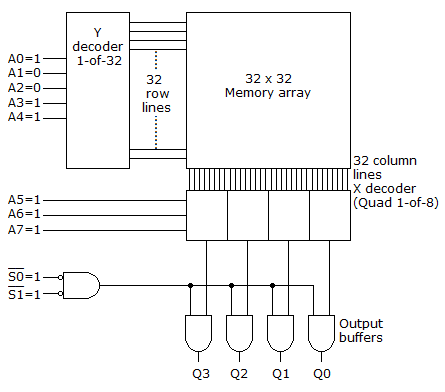Discussion
Home ‣ Digital Electronics ‣ Memory and Storage See What Others Are Saying!
- Question
Refer the given figure. The outputs (Q0?Q3) of the memory are always LOW. The address lines (A0?A7) are checked with a logic probe and all are indicating pulse activity, except for A3, which shows a constant HIGH, and A7, which shows a constant LOW; the select lines,
 are checked and
are checked and  shows pulse activity, while
shows pulse activity, while  indicates a constant HIGH. What is wrong, and how can the memory be tested to determine whether it is defective or if the external circuitry is defective?
indicates a constant HIGH. What is wrong, and how can the memory be tested to determine whether it is defective or if the external circuitry is defective? 
Options- A. One of the inputs to the active-LOW select AND gate may be stuck high for some reason; take both select lines LOW and check for pulse activity on the outputs, Q0?Q3. If the outputs now respond, the problem is most likely in the program or circuitry driving the select lines.
- B. The problem appears to be in the two address lines that never change levels; the problem is probably in the program driving the memory address bus.
- C. The output buffers are probably defective since they are all tied together; the common input line is most likely stuck LOW. Change the output buffer IC.
- D. Since no data appears to be getting through to the output buffers, the problem may be in the X decoder; change the X decoder IC.
- Correct Answer
- One of the inputs to the active-LOW select AND gate may be stuck high for some reason; take both select lines LOW and check for pulse activity on the outputs, Q0?Q3. If the outputs now respond, the problem is most likely in the program or circuitry driving the select lines.
- 1. In a MAX7000S device, when an I/O pin is configured as an input, the associated macrocell can be used for ________.
Options- A. buried logic
- B. another output
- C. extra speed
- D. in-system testing Discuss
- 2. A half-adder circuit would normally be used each time a carry input is required in an added circuit.
Options- A. True
- B. False Discuss
- 3. A very important attribute of the conditional signal assignment statement is its sequential operation.
Options- A. True
- B. False Discuss
- 4. In general, when using a scope to troubleshoot digital systems the instrument should be triggered by ________.
Options- A. the A channel or channel 1
- B. the vertical input mode, when using more than one channel
- C. the system clock
- D. line sync, in order to observe troublesome power line glitches Discuss
- 5. Incandescent 7-segment displays are especially well suited for use in portable battery-operated devices.
Options- A. True
- B. False Discuss
- 6. In BCD addition, the value ________ is added to any invalid code group.
Options- A. 010101
- B. 0U812
- C. 100110
- D. 0110 Discuss
- 7. In the 74121, which is nonretriggerable, any triggers that come in before the end of the timing cycle are ignored.
Options- A. True
- B. False Discuss
- 8. SPLDs, CPLDs, and FPGAs are all which type of device?
Options- A. PAL
- B. PLD
- C. EPROM
- D. SRAM Discuss
- 9. Gated S-R flip-flops are called asynchronous because the output responds immediately to input changes.
Options- A. True
- B. False Discuss
- 10. A ROM that allows the user to program data into the chip by permanently opening fusible links is the EPROM.
Options- A. True
- B. False Discuss
More questions
Correct Answer: buried logic
Correct Answer: False
Correct Answer: True
Correct Answer: the system clock
Correct Answer: False
Correct Answer: 0110
Correct Answer: True
Correct Answer: PLD
Correct Answer: False
Correct Answer: False
Comments
There are no comments.More in Digital Electronics:
Programming
Copyright ©CuriousTab. All rights reserved.
